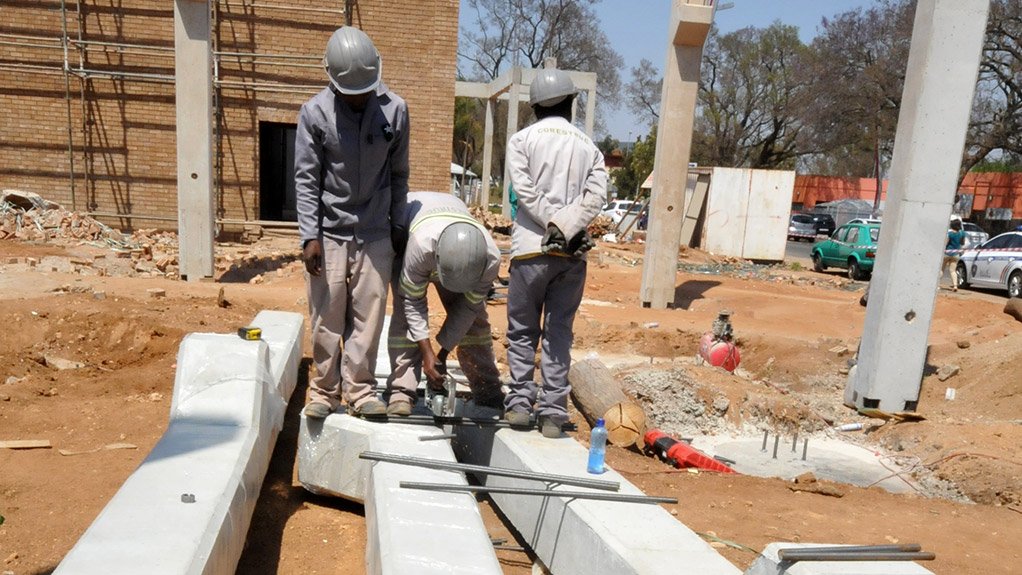Precast concrete industry drives sustainable employment and skills development in construction
This article has been supplied as a media statement and is not written by Creamer Media. It may be available only for a limited time on this website.
Leading participants in the precast concrete industry are creating sustainable employment opportunities, while contributing towards skills development in the South African construction sector. This stands out as a major industry milestone for Willie de Jager, managing director of Corestruc, a leading local designer and manufacturer of precast concrete structures.
“As precast concrete technologies and hybrid-concrete construction (HCC) gain traction in the South African construction sector, it is inevitable that the industry will continue to invest heavily into its human resources. This is considering the level of skills that are required in the various specialist components of the precast concrete construction value chain, which spans the design and efficient manufacturing of quality items through to the rapid and accurate installation of the precast concrete elements on site,” De Jager says.
Government has long acknowledged the important role that the construction sector is able to play in creating jobs and developing skills in the country. These objectives are mirrored in policy documents such as the National Development Plan (NDP).
The NDP emphasises the need for public-sector construction projects to help eradicate poverty by creating direct and indirect employment opportunities during the implementation phases of the infrastructure. This is in addition to the role that the new builds will play over the long-term in bolstering service delivery and South Africa’s global competitiveness.
Importantly, these policies place immense onus on all participants in the industry to develop skills and small-medium micro enterprises throughout the construction phases to drive transformation in the sector and inclusive economic growth.
South African construction currently accounts for 10% of the 11,2-million people employed by the formal economic sector, excluding agriculture and private households.
However, it is also important to note the critical part that the building-material manufacturing, aggregate and sand quarrying, as well as the transport industries play in creating several thousand related jobs in the country. The total direct job creation multiplier of these sectors, alone, is estimated to be more than 4,7 persons for every R1-million invested into infrastructure by government.
As a significant stakeholder in the construction industry value chain, the precast concrete manufacturing component stands out as a serious contributor to employment in the country.
De Jager says that this is an aspect that is often overlooked, considering that one of the advantages of HCC and precast concrete technologies is that less labour is required during the installation phases of the modular construction system, compared to the large teams deployed in conventional in-situ construction.
He adds, “Moreover, it must be noted that these employees work in a controlled and safer environment. Workers also enjoy secure employment, motivating ongoing investment by companies into internal skills development and training of their staff. This, in turn, has resulted in higher paid jobs and, therefore, improved living conditions.” Conversely, temporary workers on conventional in-situ construction projects seldom become permanent employees even when they do have an aptitude for construction.
In many instances, unskilled members of a community are appointed to undertake less-onerous aspects of the contract and are only recognised as semi-skilled or skilled labour once the project is completed. They are, therefore, extremely reliant on a consistent and regular pipeline of projects from the public sector for future employment.
The extent of the level of skills required in the manufacture of precast elements is largely dependent upon the nature of the precast concrete elements that are being designed and manufactured.
There are mainly two methods of manufacturing precast concrete. These include using conventional moulds, as well as traditional steel reinforcement and concrete placement techniques. Hollow-core slabs are manufactured using extrusion or slip-forming, with concrete mechanically placed on a long pre-stressing line.
The precast concrete elements are then transported to site where they are installed quickly by small and efficient teams, comprising skilled people, not least of which are the surveyors, foremen and crane operators.
“On HCC projects, they augment the skills and capabilities of the large teams that are already tasked with the various components of the in-situ works programme. In many instances, precast concrete systems are used to supplement limited skilled labour that is available for a project. A dearth of specialist skills and trades remains a major challenge for many contractors, negatively impacting productivity and safety on sites, while compromising the smooth implementation of important infrastructure-delivery programmes,” De Jager says.
He concludes that Corestruc continues to prove that the company is committed to employment and skills development in the larger construction industry, while its ongoing investment into innovation in precast concrete technologies will assist clients in accelerating infrastructure programmes in the country.
Comments
Press Office
Announcements
What's On
Subscribe to improve your user experience...
Option 1 (equivalent of R125 a month):
Receive a weekly copy of Creamer Media's Engineering News & Mining Weekly magazine
(print copy for those in South Africa and e-magazine for those outside of South Africa)
Receive daily email newsletters
Access to full search results
Access archive of magazine back copies
Access to Projects in Progress
Access to ONE Research Report of your choice in PDF format
Option 2 (equivalent of R375 a month):
All benefits from Option 1
PLUS
Access to Creamer Media's Research Channel Africa for ALL Research Reports, in PDF format, on various industrial and mining sectors
including Electricity; Water; Energy Transition; Hydrogen; Roads, Rail and Ports; Coal; Gold; Platinum; Battery Metals; etc.
Already a subscriber?
Forgotten your password?
Receive weekly copy of Creamer Media's Engineering News & Mining Weekly magazine (print copy for those in South Africa and e-magazine for those outside of South Africa)
➕
Recieve daily email newsletters
➕
Access to full search results
➕
Access archive of magazine back copies
➕
Access to Projects in Progress
➕
Access to ONE Research Report of your choice in PDF format
RESEARCH CHANNEL AFRICA
R4500 (equivalent of R375 a month)
SUBSCRIBEAll benefits from Option 1
➕
Access to Creamer Media's Research Channel Africa for ALL Research Reports on various industrial and mining sectors, in PDF format, including on:
Electricity
➕
Water
➕
Energy Transition
➕
Hydrogen
➕
Roads, Rail and Ports
➕
Coal
➕
Gold
➕
Platinum
➕
Battery Metals
➕
etc.
Receive all benefits from Option 1 or Option 2 delivered to numerous people at your company
➕
Multiple User names and Passwords for simultaneous log-ins
➕
Intranet integration access to all in your organisation





















